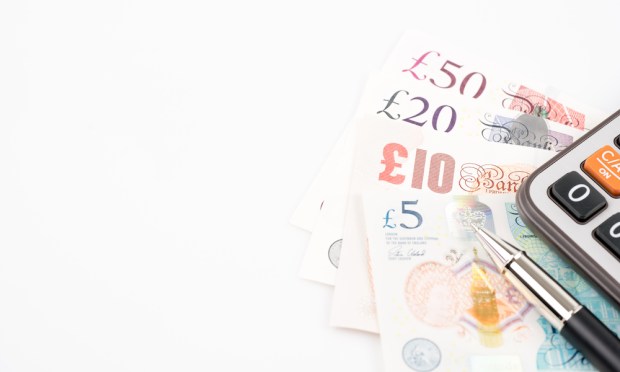In The UK, Cash And Contactless Are Vying To Stay On Top

British banknotes are practically royalty. According to research in the new PYMNTS Global Cash Index™ U.K. Analysis, physical currency is still king (and queen) of payments. And, in the land of contactless payments, its overall use is even climbing. Victoria Cleland, director of banknotes for the Bank of England, tells PYMNTS that growth is powered by popularity among consumers and easy access to ATMs. Find more, including 325 data points on cash in the U.K., inside the Index.
When the limit on contactless payments in the U.K. was raised in 2016 from £20 to £30, the overall volume of contactless payments tripled.
While, for many industry spectators, the growth in volume of contactless payments equated to a correlating drop in cash use, the actual numbers reveal that despite a growth in competition from alternate payment forms, cash is continuing to hold its ground.
As it turns out, the overall use of cash in the U.K. continues to climb. As of 2016, total banknotes in circulation grew by 10 percent to reach £70 billion — the fastest growth in a decade, according to the Bank of England (BoE).
To gauge the factors powering cash’s growth, PYMNTS recently caught up with BoE’s director of bank notes and chief cashier, Victoria Cleland, who oversees the production, distribution and security features of banknotes. Cleland explained many facets of the current state-of-cash, including its changing accessibility and evolving role in consumer preferences.
With more competition from alternate payment forms these days, cash may not be the only choice consumers have, but it continues to be a payment method to reckon with, she said.
And rightfully so. Cash accounted for 40 percent of all payments and 44 percent of payments made by consumers in the U.K. in 2016, according to BoE’s data.
Where cash stands today
While the transactional demand for cash has been slow in the country, it has maintained a stable course. With cash powering 44 percent of consumer payments, it’s still a very popular method of payment — but, alternate payment methods are cutting into some of its overall share, Cleland said.
In fact, some of the competition cash faces in the U.K. today has come with the growth of contactless payments.
Initially, when contactless payments were introduced, consumers used them in place of traditional debit or credit cards rather than cash, Cleland said. But, as contactless terminals have become more ubiquitous in the U.K., they are now being used for much smaller-value transactions.
With the average value of cash transactions remaining steady at around £10, the payment method will continue to be widely used for day-to-day small-value transactions, she said. As such, even if the £30 limit on contactless payments were to be raised, it’s less likely to impact use of cash.
Changing accessibility of cash
As with other developed economies, a growing adoption of online and mobile banking in the U.K. has led to a reduction of the physical footprint of bank branches.
In August 2017, Barclays announced plans to shutter 54 bank branches as part of its cost-cutting efforts, and it isn’t the only bank closing branches in the country. Royal Bank of Scotland announced its plans to close 180 branches in March. Lloyds and HSBC were also among big financial institutions (FIs) planning to collectively shutter more than 200 U.K. branches.
For consumers, this shrinking physical footprint has also meant changing accessibility to cash. But, perhaps surprisingly, there’s now increased availability, according to Cleland.“The number of traditional bank branches has been reducing, but at the same time we are seeing an increase in the number of ATMs,” she said.
With the shift, most of the U.K.’s population is now withdrawing cash from ATMs, Cleland added. Meanwhile, consumers continue to have the option to withdraw and deposit money at the 11,500 post office branches spread across the country.
The decline in the footprint of physical branches is also motivating banks to look for alternate solutions to better serve customers living in less populated areas.
“Banks are also looking to introduce mobile branches that actually drive from one place to another, for enabling people to deposit money back,” she noted.
Where cash is headed
Alternate payments methods might be gaining popularity among millennials in the U.K., but cash seemingly continues to have a loyal and slightly growing user base.
As of 2016, some 3.7 million people in the U.K. relied almost entirely on cash transactions, a 0.5 percent increase over 2015, Cleland said. Meanwhile, small businesses continue to prefer accepting cash over credit, debit or contactless payment.
Retailers’ average cost per cash transaction measured as a percentage of cash turnover was 0.15 percent in the U.K., the same as 2015, whereas other payment methods cost 0.31 percent, according to 2016 study findings by the British Retail Consortium.
“Cash is still the cheapest payment method and small businesses usually don’t want to take cards, particularly for small value payments,” Cleland said. “They will only accept a card payment over £5 or £10.”
Additionally, with factors like cybersecurity concerns around the use of alternate payment methods, the tangibility of cash and its use as a budgeting tool continue to drive its use.
“At the Bank of England, we see that there’s strong demand for cash and expect that to go into the future,” she added.
In response to the growing demand, the BoE is introducing new polymer versions of its bank notes, which are intended to have more longevity and improved security features and make them more difficult to counterfeit than their predecessors.
“We introduced the new £5 [polymer] note last year featuring Winston Churchill, and we introduced the £10 [polymer] Jane Austen note and then, in 2020, we are going to introduce a £20 polymer note featuring JMW Turner, an acclaimed British painter,” Cleland said.
In the end, while she doesn’t have a crystal ball, she foresees cash sticking around for a long time.
And, with that, perhaps, consumers will increasingly pair cash and contactless payments in their day-to-day transactional lives.
To download the PYMNTS.com Global Cash Index™ U.K. Analysis, please click below.
About the Index
The PYMNTS.com Global Cash Index™, a Cardtronics collaboration, focuses on the use of cash for making payments and as a payment method that equally plays a role with cards, checks, direct debit and other methods of settling up between consumers and businesses. Unlike most reported estimates of cash, our proprietary data analysis focuses on the use of cash for making payments rather than hoarding.

